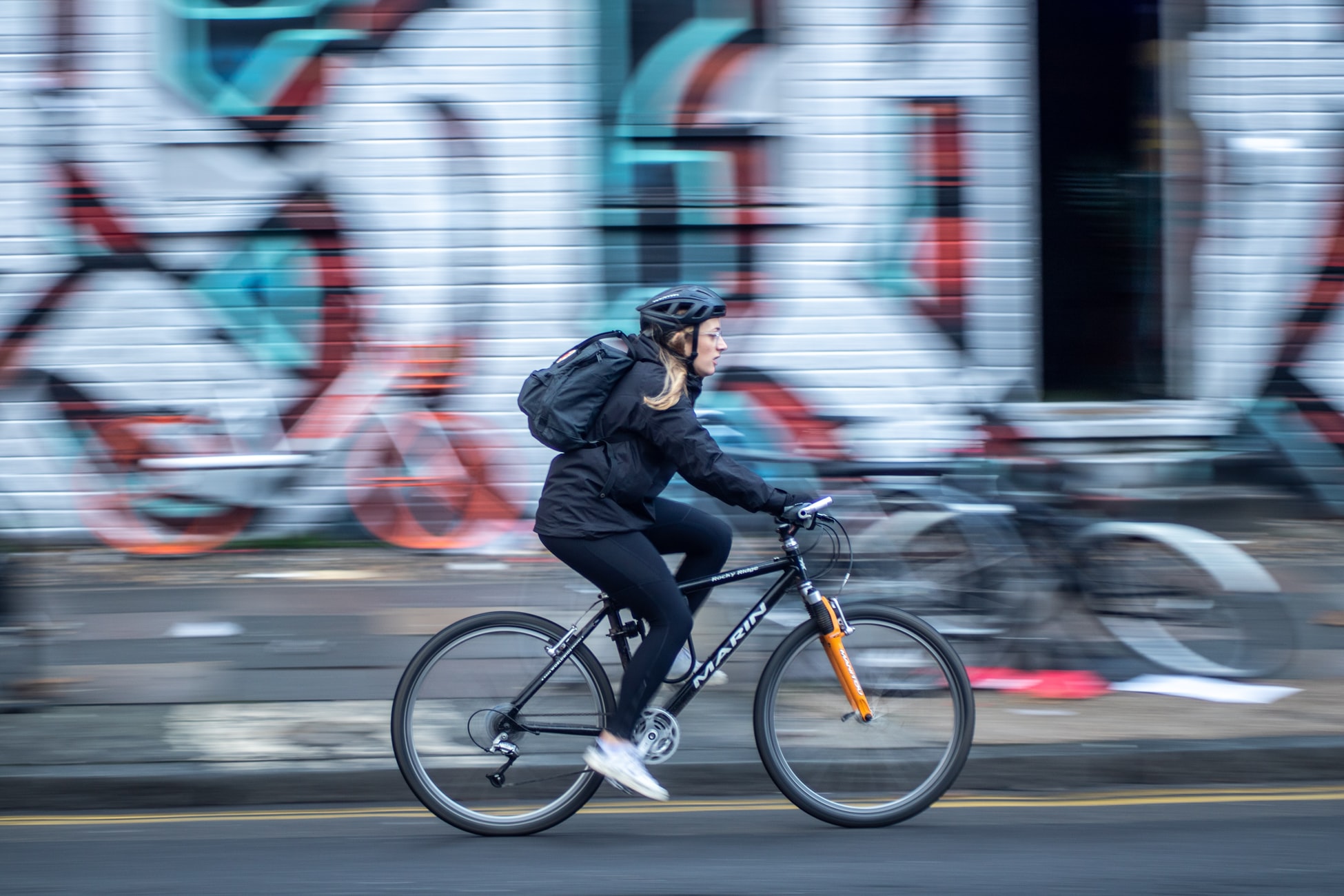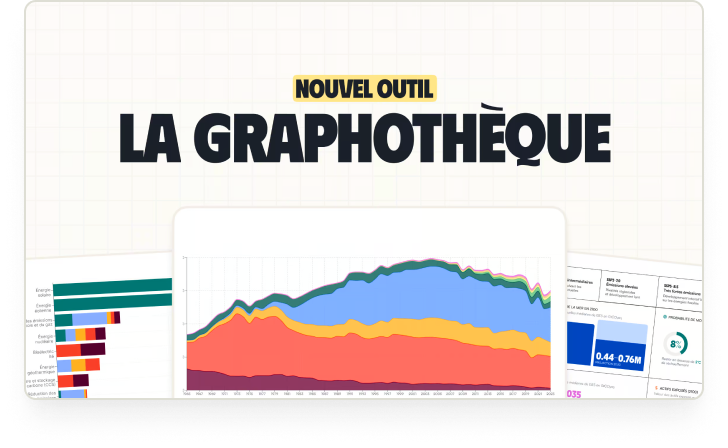A few months ago, I asked Guillaume Martin (mobility consultant at BL évolution) if he was motivated to write a few lines about cycling to be published on Bon Pote. He came back to me with almost 60 pages of content, well argued, illustrated and sourced!
To facilitate the reading, we will publish this file in 5 parts, which can be read in a row or independently from each other.
- Part 1: Mobility structures our lives but has a heavy economic, health and ecological impact
- Part 2: Why develop cycling? Making the case for the bicycle
- Part 3: You’re very kind, but my grandmother or my plumber will never ride a bike: stop the preconceived ideas
- Part 4: Cycling is the best way to decarbonize our mobility
- Part 5: Building a bikeable France
As all everyday cyclists will tell you, the first argument in favor of the bicycle is often that it is a practical, inexpensive and pleasant means of transportation that gives its user a feeling of freedom and a capacity to travel that is both simple and terribly efficient. In short, it is a great way to improve quality of life, as the many testimonials in the film Why We Cycle show. Before looking in detail at the benefits of cycling in terms of greenhouse gas emissions, let’s start by looking at the benefits of cycling in terms of community finances, jobs, health, calming public spaces and reducing the amount of land used.
Cycling is a strong lever for job creation and a vector for access to employment.
While the development of the electric car risks eliminating many jobs in the automobile industry, several studies show that the bicycle is a formidable creator of jobs. A whole bicycle ecosystem remains to be built (as we shall see in part 5), and there will be jobs for all. Compared to other modes of transport, active mobility (walking and cycling) creates the most jobs, particularly because bicycle assembly and maintenance are difficult to relocate and because the distances covered are shorter, the bicycle system requires a greater density of services.
Today, despite the low number of trips made by bicycle (3% modal share), the direct economic impact of bicycle use is estimated at 9.6 billion euros per year and nearly 80,000 jobs. ADEMEestimates the total employment potential of cycling in France at around 200,000 full-time equivalents (i.e. roughly the number of jobs in the automobile industry, 229,000 jobs in 2020). This is a major challenge, because unlike the automobile industry, working in the bicycle industry is a way to ensure a future job that is compatible with carbon neutrality.
Bicycles are not expensive (for the community, households, etc.)
For households, the bicycle is obviously one of the most economical means of transportation after walking. Using a car implies many costs for its owner (the purchase of the car, fuel, maintenance, insurance, parking, repairs…). This cost is estimated at about 5000 € per year. The bicycle costs much less. An everyday cyclist rarely spends more than 500 € per year (and with that, he will have the chance to ride the best bike written off over several years). Most everyday cyclists spend a few dozen euros a year at most.
Recent investments in cycling have raised a few voices. Bicycles would be a financial drain for the State and local authorities wishing to develop their use. It is true that providing quality bicycle facilities (the first lever for developing bicycle use, see part 4) costs little money. The cost of a kilometer of bike path can vary from €100,000 to €1,000,000 depending on the context (urban, rural), the technical difficulty of the work (presence of buried networks, unevenness) or the quality of the desired development (paint on the sidewalk or Dutch-style development).
However, there are several points that put all this into perspective:
- When it comes to infrastructure, in general, the bill climbs quickly. Compared to road infrastructure, developing and maintaining a bicycle network is much cheaper for a variety of reasons (lighter and slower vehicles, smaller lane widths, safety constraints, etc.). The cost per kilometer of a new road is in the order of several million euros and can reach 100 million for highways, for example, which is 200 times more expensive than a bicycle path, according to economist Frédéric Héran(excluding induced costs). The development of one kilometer of tramway costs between 25 and 30 million euros.
- These costs do not take into account the financial impacts induced (externalities) by these modes of transport. A recent Quebec studystates that for every $1 paid by an individual to travel by car, society pays $5.77 (infrastructure, pollution, accidents, etc.). For the same amount paid by the individual to travel by bus, society pays $1.21. For $1 paid by an individual to travel by bicycle or on foot, society pays only $0.22, notably because of the savings generated on health services.

In France, the annual cost of road construction and maintenance is estimated at 13.3 billion euros by the URF (Union Routière de France, which brings together motorists associations and companies in the road and automobile sector). It is clear that with 13 billion euros per year, France could make itself bikeable! But these are only the direct costs. Should we add to the bill, for example, the 44 billion euros per year linked to road accidents according to the National Interministerial Observatory for Road Safety (NIORS)? Not to mention noise, air pollution, health costs related to sedentary lifestyles or the future cost of climate change!
Society subsidizes 55% to 70% of the costs related to the use of the car
While the car driver is often identified as the cash cow of the French administration, a recent study by the French Treasury has shown that regardless of the type of engine used, car drivers only pay a part of the real cost of their trips despite the withholding via fuel taxes, tolls or registration fees.
In reality, all the taxes cover only 30% (diesel engines) to 45% (gasoline engines) of the externalities generated. Thus, society subsidizes 55% to 70% of the collective costs related to car use, an amount estimated at 46 billion euros per year. In the end, when we use our car while having a better means of transport, we are behaving in a rather selfish way, putting the impacts of our travel on the whole of society, including non-automobilists. And all of this depends, of course, on the costing of these externalities, which is open to debate. For example, this study takes into accountthe carbon price estimated for 2015 at 42€/tCO2e (in short, the monetary value at which it is profitable to finance decarbonization actions). This value is already equal to 87€ in 2020 and should reach 250€ in 2030 according to the Quinet II report. Note that not all externalities such as noise are taken into account in these calculations. For example, a recent ADEME studyestimated the social cost of noise at €156 billion per year, 52% of which is due to road transport.

NEWSLETTER
Chaque vendredi, recevez un condensé de la semaine, des infographies, nos recos culturelles et des exclusivités.
ALERTE
Une alerte dans votre boite mail, pour être mis au courant dès qu’un nouvel article est en ligne sur Bon Pote
Cycling is (very) good for your health (and your health insurance)
Another argument, and not the least, is that cycling is an excellent remedy for the evil of the century: a sedentary lifestyle and lack of physical activity. According to the WHO, less than 37% of adults, 32% of people over 65 and less than 34% of children under 11 are sufficiently active. According to another OECD study, only 6% of French girls are sufficiently active (at least one hour per day).
If a drug existed with the same effects, it would be called a magic cure.
Sir Liam Donaldson, former Chief Medical Officer of England
Favoring cardiovascular and musculoskeletal functions, cycling preserves and strengthens the joints (arthritis, back pain…) and greatly reduces the risk of early death (especially those related to heart attacks responsible for 18,000 deaths per year, i.e. 10% of all deaths).
A Danish study (a country with a strong cycling culture) carried out in 2000 on 30,000 men and women of all ages shows that the use of bicycles for daily travel results in a 28% reduction in the risk of premature death (Andersen L.B. Et al. June 2000). In France, in 2013, the Ministry of Ecology estimated the risk reduction for several major pathologies: minus 30% for coronary heart disease, minus 24% for cerebrovascular disease, minus 20% for type 2 diabetes, minus 15% for breast cancer, minus 40% for colon cancer… More recently, a study by ANSES (Agence Nationale Sécurité Sanitaire Alimentaire) stated that daily cycling reduced early mortality by 29% to 41%. Cycling is a real life insurance!
In 2008, a first study on the economics of cycling estimated the positive health impacts of cycling in France (based on a 2% modal share at the time) at nearly 5.6 billion euros per year (enough to finance a nice cycling plan). A more recent study by ADEME puts this figure at nearly 11 billion euros of savings generated per year for French society.
Finally, some studies (Praznoczy, 2012) go as far as to compare these health benefits with the possible risks associated with the daily use of bicycles for transportation (air pollution, risk of accident, etc.). As we shall see, the more cycling develops, the more the risks decrease. But even today, the benefits of regular cycling are 20 times greater than the risks and could be nearly 30 times greater if cycling continues to develop.If we come back to the subject of time saved or lost, we realize thatby extending our life expectancy in good health, cycling saves us precious time and a certain quality of life!
Bicycles limit the artificialization of land
This necessary network is estimated at about 100,000 km of cycling facilities. These potential bicycle infrastructures would therefore be in competition with other land development projects that involve land consumption (the transformation of natural or agricultural areas into urbanized, concrete areas). These impacts are sometimes evoked to oppose investment projects in cycling infrastructure because France has committed to a Net Zero Artificialization Objective (ZAN). However, on closer examination, bicycle facilities represent a tiny proportion (0.20%) of the artificialization in Franceor even 0.5% of the surface area artificialized by transport infrastructures. It can be estimated that 70% of these bicycle facilities have been built on already urbanized areas, where the population and living areas are located.
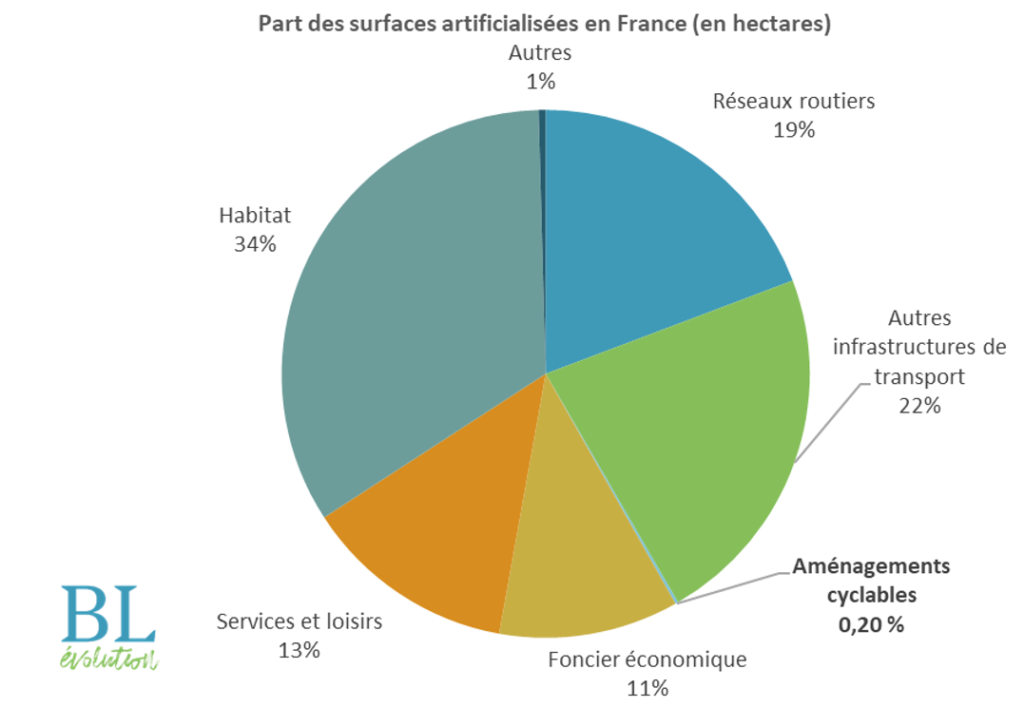
To develop 100,000 km of safe bicycle facilities, a maximum of 30,000 ha would be required, which in the worst case scenario would represent 0.70% of the total artificial land surface in France. In reality, a large part of these facilities will certainly be built on artificial surfaces (in urban areas), so this figure can be put into perspective.

Various flow studies can be used to estimate the number of people who can travel using a given mode of transport on a given road. While some bicycle counters easily exceed the number of motorists at peak hours, the maximum flow can be estimated at about 7,500 people per hour on a dedicated bicycle lane without saturating the infrastructure. This is less than the same space dedicated to walking (9,000 people per hour), but the bicycle allows its user to travel further or faster. It is less than a heavy public transport system (subway, tramway…) which can transport 10 to 25 000 people per hour.
But these are very expensive, saturate quickly in very dense areas, and are difficult to finance elsewhere (the COVID crisis has hurt the public transport sector). On the other hand, bicycles can relieve the burden on public transport systems in the most densely populated areas where there is little possibility of extending or improving the network (number of trains, frequency of service, etc.). For many workers with shifting work schedules, bicycles offer a way to travel at times when it would not be appropriate to operate a massive public transport service.
7,500 people per hour is much more than a car lane can carry. Beyond 1500 vehicles per hour and per lane, a roadway reaches its maximum capacity from 70km/h average speed. The average occupancy rate of cars in France is around 1.2 for home-work trips and rises painfully to 2 for certain leisure trips. We therefore obtain that one car lane allows to move about 1700 people (home-work) and 3000 people (leisure/holiday). This incredible efficiency allows the bicycle to compete with any means of transportation in dense urban areas.
This is even more noticeable when you look at our public space from above. The picture below shows a parking lot in Eindhoven station. The same space is occupied by 75 cars and more than 500 bikes. In France 60% to 80% of the public space is dedicated to cars.
Let’s take advantage of the fact that we are talking about parking to do a little exercise (and sorry for those who don’t like calculations). For a Parisian resident, the cost of on-street parking is a maximum of 513€/year (45€ for the resident card + 9€/week). For a 11.5m2 parking space, this amounts to about 4€/m2/month, whereas the price of renting an apartment (or a storage unit) is around 25 to 40€/m2/month, depending on the district. This example is obviously cartoonish since Paris is one of the most expensive cities in the world (and fortunately less than 33% of Parisians own a car). Nevertheless, we can see here the crucial issue of sharing public space.
The extreme sobriety offered by the bicycle allows us to have a travel solution that consumes little space. The benefits of the bicycle in terms of limiting the artificialization of land go even further. Indeed, there is a virtuous loop between the development of cycling infrastructures and the transformation of mobility habits around living and local centers. The development of cycling practices guides land-use strategies by limiting the artificialization of land through the densification and polarization of travel.
Since the 1950s, the amount of artificial land in France has grown three times faster than the population, with urban sprawl being one of the causes. The growing use of cars is both a cause and a consequence of urban sprawl. On the one hand, the distances to be covered on a daily basis are increasing towards the suburbs and households are turning to the personal car. On the other hand, land use planning has been built around the car, which leads to urban sprawl.
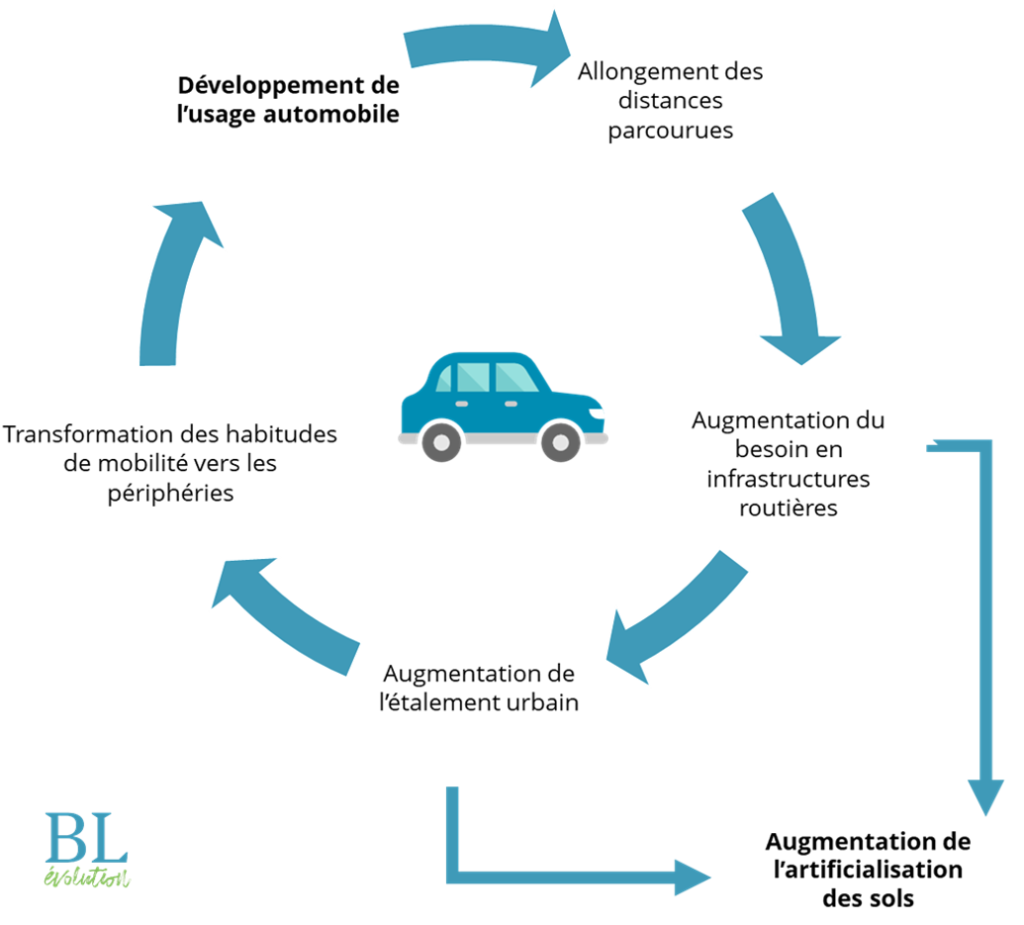
When a region seeks to promote bicycle use, particularly by developing bicycle infrastructures, bicycle parking or dedicated services, it comes to questioning the organization of public space, the forms of housing and commerce. When it creates cycling infrastructures, it encourages the development of lifestyles built around the bicycle as the main means of travel. In this way, it favors the forms of housing and commerce favored by its residents who travel short distances. Very quickly, for example, it becomes necessary for cyclists to favor local shops in the neighborhood or town center rather than distant purchases in the suburbs or in the neighboring agglomeration. Just as the car has increased speed and mileage tenfold, the bicycle can reduce the distances traveled and thus help reduce land consumption related to urban sprawl.
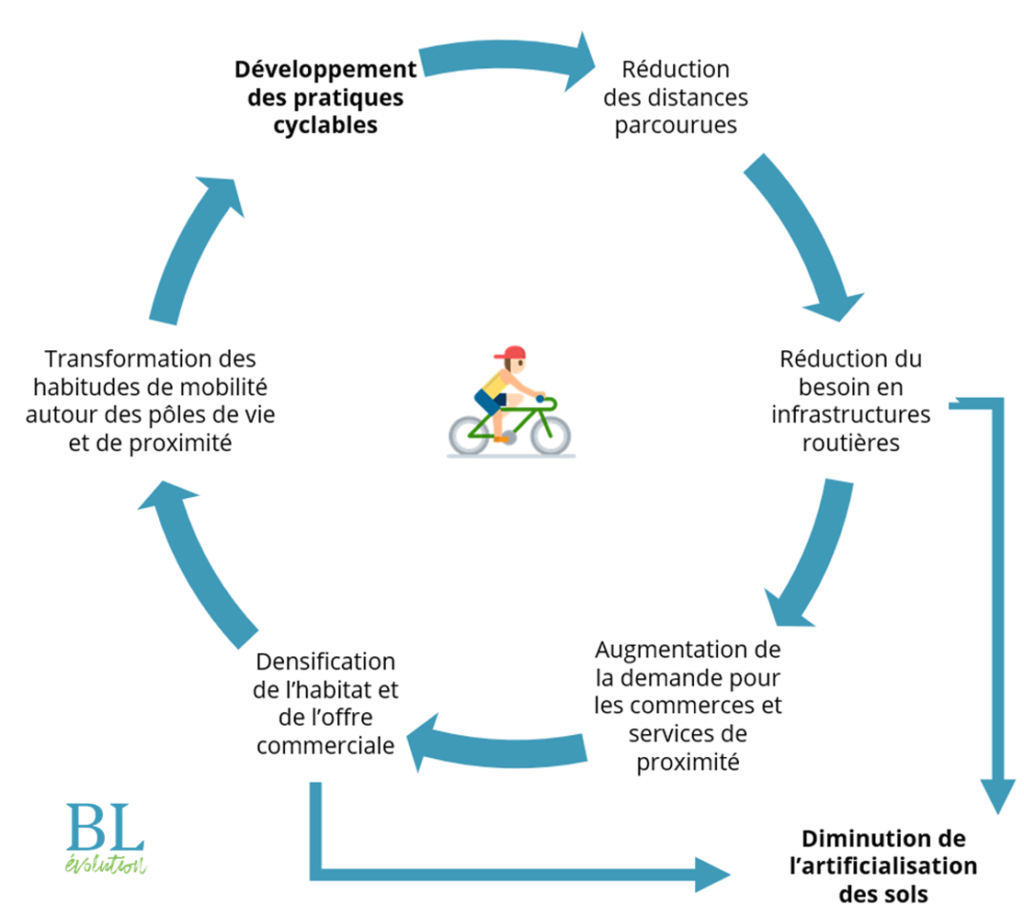
Bicycles are a vector for social bonding and the calming of public space
Cycling is also a means of “calming” public space, i.e. a space where traffic moves more slowly and where people pay more attention to each other. If you have ever ridden a bicycle, you may have already observed that we are much more attentive to the environment around us (and to others, apart from a few road rage people whatever the mode of transport) when we ride a bicycle than when we ride a car.
Another observable and fairly well known element is “safety by numbers”: the more cyclists there are on the street, the more motorized users tend to pay attention to them. The consequence, confirmed by several studies:the death rate of cyclists decreases with the number of cyclists.
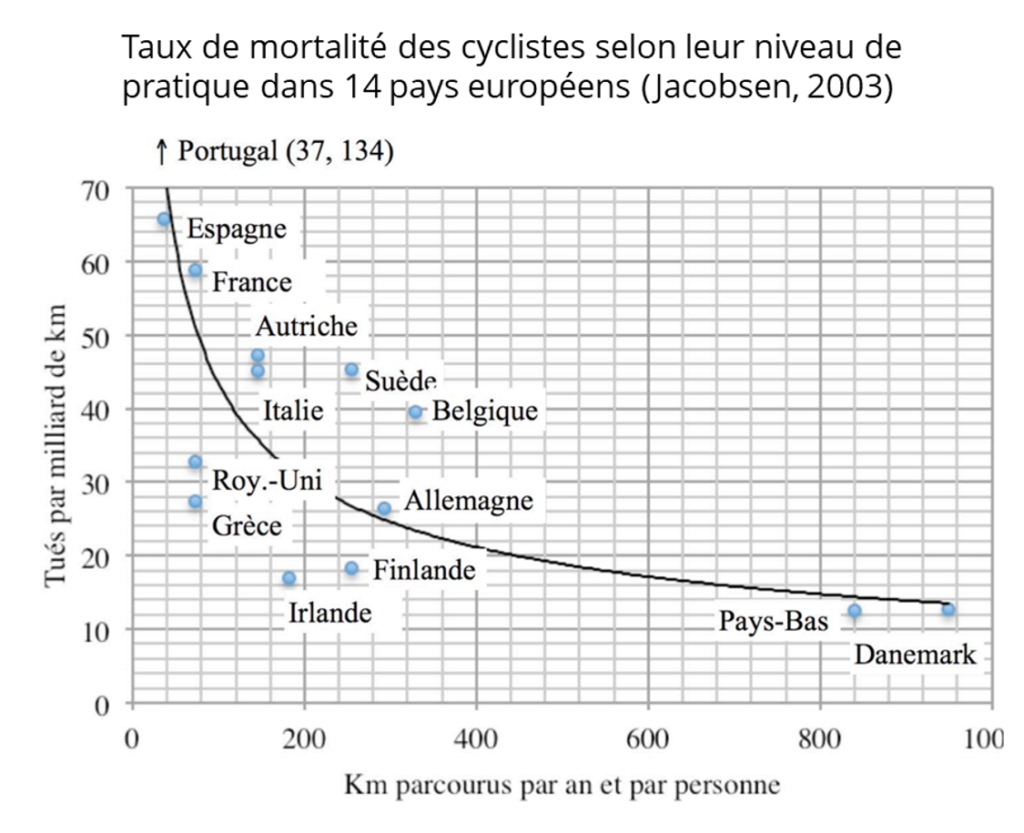
This is actually very logical for several reasons, explained in the following three diagrams.
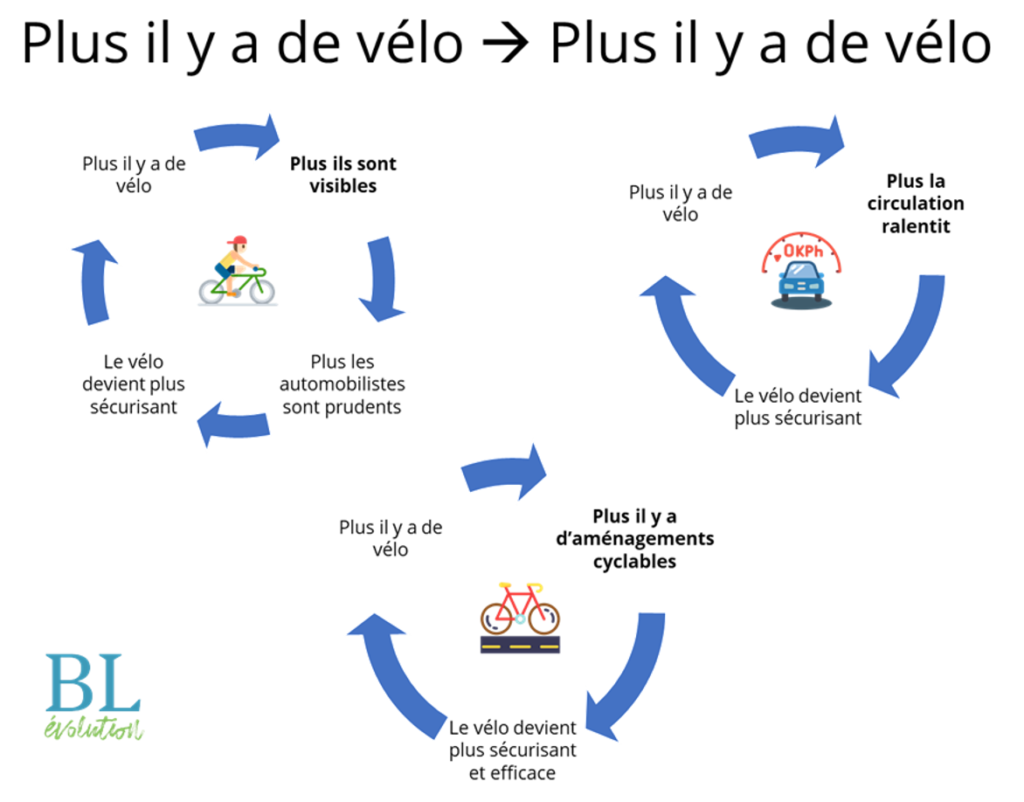
How can public space be calmed from a technical point of view? There are two parameters to consider when thinking about the cyclability of a road or street: the speed of motorized traffic and the volume of traffic (the number of vehicles per day). Thus, below 30 km/h and a volume of 4,000 vehicles/day, it is possible to consider sharing public space without bicycle facilities. Beyond this level, or for certain roads that require significant bicycle traffic, bicycle lanes are necessary. It should be noted that to limit the speed to 30 km/h, a simple sign and a coat of paint are not enough. Soothing measures are needed to make the speed limit effective, such as narrowing, locks and plateaus, or controls and possible penalties for exceeding the speed limit. In order to limit traffic to less than 4,000 vehicles per day on small streets or in residential areas, each city must consider its traffic plan to avoid having too many vehicles passing through entire neighborhoods without ever stopping: in this case, it is preferable that vehicles use the main roads provided for this purpose.

Reducing the speed limit in cities to 30 km/h is therefore a lever to promote the cyclability of our public space. This 30 km/h limit is easily explained. This is the speed at which a collision with a motorized vehicle becomes fatal, as described in the infographic below. Lowering the speed limit from 50 to 30 km/h reduces the risk of a fatal accident by a factor of 5. And contrary to a common misconception, limiting speed to 30 km/h does not increase pollution, on the contrary.
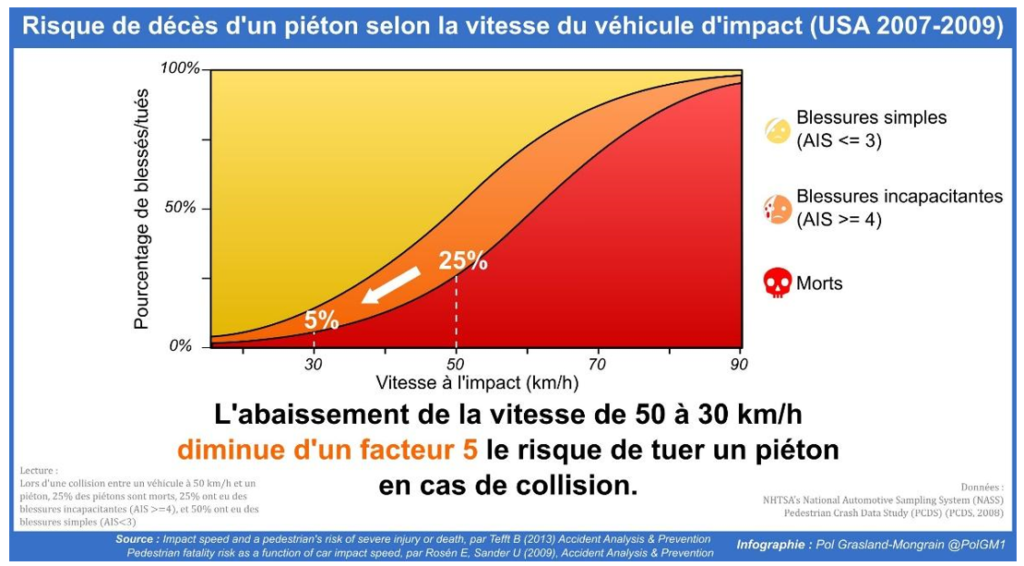
Thus, many cities, small or large, have chosen to limit traffic speed to 30 km/h. Although this is not enough to implement a pro-bike policy, it is a step in the direction of calming down public space, which contributes to the development of everyday cycling. And vice versa.

Conclusion of part 2
Cycling therefore seems to have many advantages. We’ll talk more about its ecological advantages in Part 4, but first I’d like to deconstruct a few preconceived ideas about the disadvantages of cycling in Part 3!

